The mystery of how to make money from a website is a subject that baffles some of the greatest finance gurus of today, but it doesn’t need to be that way.
There are always new ways to set up a side hustle online—some being more viable than others. And since money never sleeps, let’s not waste time.
1. Affiliate Marketing
- Advantages: low barrier to entry, relatively inexpensive to set up, convenient, flexible, you get to be your own boss, has performance-based income
- Disadvantages: highly competitive, rapidly shifting landscape, low commission, no guaranteed revenue
Affiliate marketing is a business model where independent marketers (also known as affiliates) promote other people’s products and services in order to earn a fixed commission whenever qualified leads buy these products through their channels.
In this arrangement, affiliates earn a commission if and only if a lead performs a qualified action (such as making a purchase) after being redirected to the sales page via something known as an affiliate link, which is issued for each product by the affiliate program holder (e.g., a vendor like Amazon or Chewy).
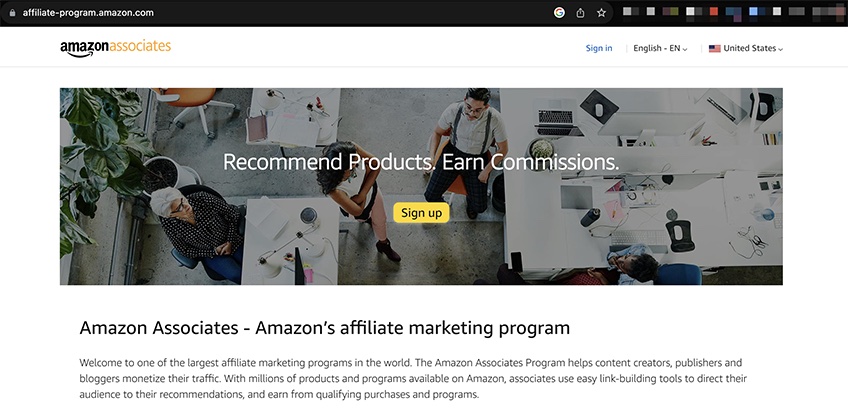
Given that affiliate marketing is heavily based on the performance of the affiliate marketer’s website and how well it manages to turn leads from its target audience into buyers, this marketing approach is also known as performance-based marketing. In general, commissions come in a range from 1% (for things like video game consoles purchased from Amazon) to 30% (for reservations made on Booking.com), and it all depends on the niche.
Becoming an affiliate marketer means choosing a product or a range of products in a selected category, preferably one that you understand well and would genuinely enjoy promoting every day. Likewise, you should also be willing to provide your audience with relevant, objective, and unbiased reviews every time they land on your site and take an interest in one of your featured products.
One of the many alluring aspects of affiliate marketing is the fact that you have complete freedom over how you promote your chosen products, as long as they fall within the affiliate guidelines provided by the vendor. This means that everything else surrounding the promotional aspects of your advertising strategy—including any social media promotions, paid advertisements, or word-of-mouth marketing—is left up to you as the affiliate marketer. It also means that you decide your own budget.
Speaking of budgets, the affiliate marketing model is considered to be one of the least expensive ways to jumpstart an online business, with costs varying anywhere between $500 to $2,000 to run your affiliate website.
This estimate includes expenses related to:
- Buying a domain name—ranging from $5 for a basic domain name to over $1,000 for a premium domain name
- Subscribing to a hosting plan—starting from $50 for a yearly subscription on a shared hosting plan to over $500 for a dedicated hosting server
- Paying for additional security services—starting from $20 up to over $500 depending on the number of services and the complexity of your chosen security package
- Paying for content—starting from $50 for a single article to over $1,000 for a batch of articles
- Overhead costs—ranging from $0 to over $1,000 for tools you didn’t know you needed but turned out essential for operating your site, including various SEO and analytics plugin purchases, paying attorney fees if and when your site grows big enough to require them, and paying SEO technicians to optimize your site’s speed and improve your site’s conversion rates as well
As it stands, affiliate marketing is the go-to way for new marketers to break into the online money-making world. For some, it’s also a big stepping stone towards building a personal brand that creates, promotes, and sells its own products.
2. Online Advertising
- Advantages: the ability to target specific customers, full insight into ad performance and statistics, a wide range of formats to choose from, lower cost
- Disadvantages: limited space for banners, diminishing performance, somewhat confusing to set up and track for rookie marketers, increasingly tough competition
In simple terms, online advertising is a form of online marketing that uses websites, emails, and/or social media feeds to show relevant ads to incoming visitors in hopes that they purchase the products being promoted. The main advantage of online advertising over using more traditional marketing methods (like newspaper ads) is the ability to target specific groups of customers and even tailor campaigns for smaller subsets of relevant customers within those initial groups.
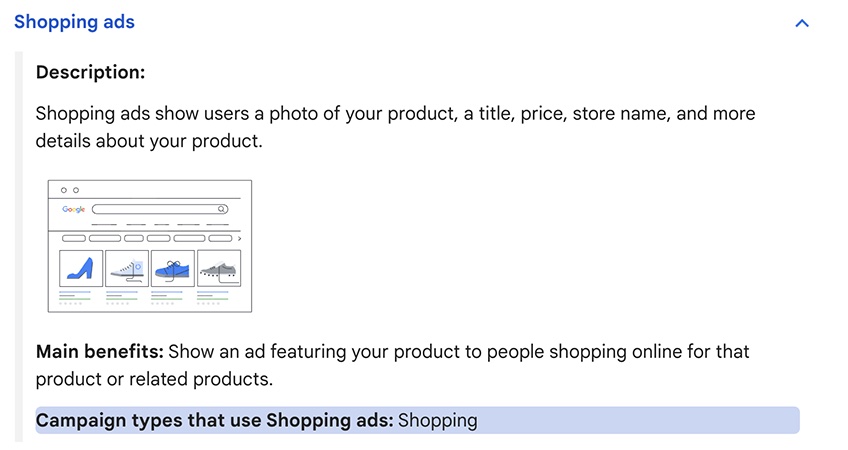
There are five main types of online advertising:
- Display advertising—visual ads that promote your products on third-party websites or other products on your own website
- Pay-per-click (PPC) advertising—ads that appear in Google Search as promoted results
- Social media advertising—ad cards that appear in social media feeds of targeted users
- Video advertising—skippable or unskippable short video clips that usually appear on YouTube, Twitch, and TikTok before, during, or after the main video content has been queued by the user
- Native advertising—embedded or camouflaged ads that promote relevant products on a website or blog’s general pages
In theory, earning money from online ads should be easy enough that anyone with the right mindset and sufficient motivation can do it. In practice, however, it’s a lot tougher than it may seem on the surface because you need to figure out a lot of variables before you can even sign up for a specific ad program like Google AdSense.
Some of the most important variables to consider before engaging in online advertising include:
- Picking an ad partner that aligns with your site’s interests, goals, and values the most out of options like Adsterra, Adroll, Taboola, and the highly dominant Google Ads ecosystem
- Deciding what kind of products you’d like to promote, with the slight caveat that you often don’t exercise full control over the type of ads that get shown if you’re opting for dynamic instead of static display ads
- Figuring out the number of ads to show, as well as their format, position, size, style, featured text, and color scheme
In a nutshell, the online advertising monetization model is fairly easy to explain. Once you enter into a partnership with an advertisement network of your choice, the network sends you several code snippets (which is how the ads look on the backend side of things) and a set of instructions on how to implement them onto your site.
Assuming that your code snippets are set up correctly, your site’s visitors will be shown relevant advertising banners to click on, an action that can earn you a small commission based on two main price models: cost-per-click (CPC) or cost-per-mille (CPM).
In the CPC model, advertisers pay publishers when a visitor clicks on the ad, whereas in the CPM advertising model, advertisers pay publishers when a visitor sees the ad but doesn’t necessarily click on it—which is also sometimes referred to as an ad impression.
Lately, all forms of online advertising have seen a steady decline in click-through-rates (CTR) because internet users have become more skeptical about trusting online ads, while some users are even going as far as using various ad blockers to stop intrusive ads from appearing to them while they browse. On top of that, some ad networks are constantly adding more complexity to their advertising guidelines, and due to this, marketers are put in a tough position of having to push regular updates to their ads in order to avoid losing their current and future partnerships.
Despite the negative impact of these setbacks, online advertising is still considered a viable method of building steady income on the side—which in some cases can mature into a main source of revenue if you adapt quickly and serve your audience ads that they don’t mind seeing or find interesting enough to click on.
3. Dropshipping
- Advantages: low overhead costs, flexible working schedule, no field stock management, no need for a brick-and-mortar store, make payments only when you sell
- Disadvantages: complicated customer service, little control over product quality, messy return processes, relatively low-profit margins, shipping operations are outside of your control
Dropshipping is a type of ecommerce business model where the seller does not manage an inventory of items, but instead processes orders through a third-party supplier who delivers them to the end customer.
Compared to traditional retail, the business owner of a dropshipping service doesn’t even own or rent physical space for inventory and mainly relies on the manufacturer (or on a different wholesale business) to deliver the goods on-demand whenever an order is made through their website. Altogether, running an online dropshipping business is kind of like being an intermediary between the end customer and the manufacturer—and you just pocket the difference in price.

To start a dropshipping business, you need a working computer, internet access, and an
investment of anywhere between $100 and $500 to cover the initial expenses. These include registering a domain, purchasing a hosting package, and creating an online inventory of products that you want to sell.
A generous estimate from the time you create your dropshipping business to the time it turns a profit can vary between three and nine months, or even a full year if you consider the full extent of unpredictability that comes with running a fully operational dropshipping service.
In the beginning, running a dropshipping store requires focus on three main fronts:
- Managing orders
- Dealing with customers and their concerns
- Performing basic accounting
As your dropshipping business grows, you’ll need to leave room to add tools for analyzing traffic, improving CRO, and raising CTRs to refine your product offerings and challenge your competitors over the long haul.
Though it may look simple on the outside, dropshipping is a complex operation that involves multiple moving parts. It also involves risk on the part of the seller, mainly because most dropshipping startups don’t make it past their infancy stage—and the ones that do usually become tougher to manage after they survive the initial pressure to stay afloat.
Comparatively speaking, dropshipping is not a business venture for new marketers or entrepreneurs with an aversion to risk, because it can take a while before it becomes profitable—if at all. Plus, dealing with customers can also be tricky if you’re not ready to consider the various personalities that you may encounter during your dropshipping tenure. Similarly, many issues can arise from incorrectly shipping an item or badly handling a dissatisfied customer’s return order.
But despite the challenges involved in running a dropshipping venture, this method is flexible enough to turn into a steady source of income after being online and fully operational for at least three successive months. If you’re lucky, you could even get there sooner.
4. Sponsored Blog Posts
- Advantages: more trusted than display ads, a non-committal form of advertising, very flexible, great for SEO, doesn’t disrupt the theme of your existing content
- Disadvantages: more biased than non-sponsored content, requires a disclaimer, less trusted than objective product reviews, limited sponsorship opportunities
A sponsored blog post is a form of paid content advertising that appears on a publisher’s website, typically written by the promoter of a product or service in the same style as the rest of the content on that site.
For a sponsored blog post to be successful, it must be at the same level of quality as the non-paid posts. Otherwise, the readers might end up dissatisfied with the sudden drop in quality and start having second thoughts about visiting again. Remember, all it takes is one negative experience for some people.
Next, some of the biggest challenges about creating a sponsored section are that you must have a reliable audience, a reputable brand, and consistent web traffic for content advertisers to consider your site a viable place to advertise their products in the first place.
Now, assuming that your site can attract sufficient interest from clients who are willing to advertise their stuff on it, earning money from sponsored blog posts is very straightforward. Once you arrange the terms of the sponsorship, have one of your writers (or someone from the advertiser’s content team) create with the post, and once it’s done, simply upload it via your content management system (CMS) together with a sponsorship disclaimer above or under the title as a separate heading.
Keep in mind that trying to disguise your sponsored blog posts as regular content without explicitly marking them as promotional is a bad practice that can lead to your site being penalized by Google in search results pages.
Anyway, if you already have a popular website that generates a sufficient amount of traffic to sustain the site, then sponsored blog posting can become a viable source of extra income that doesn’t take up a lot of resources to set up and manage. If you’re just starting out, however, first you’ll need to build up your site’s traffic, domain authority, and organic backlinks. Only then will you be able to build an attractive package to procure sponsored posts.
It can take anywhere between three months and a full year before you can accomplish your goals here. This is a high barrier to enter, especially when the expenses can be equal to those of starting a new site from scratch and paying for external outreach to generate new leads via email, for example.
In its present form, offering to feature sponsored blog posts for a flat price certainly has its merits—like high cost-effectiveness—but it’s far from being the ideal way of making money from a website.
5. Premium Content
- Advantages: provides a consistent revenue source, increases your brand authority if done right, is more financially reliable than ads
- Disadvantages: might prevent or even stunt growth, not the most popular form of monetizing a site, doesn’t sit well with the open nature of the internet, paywalled content has to be of very high quality, can be hacked and distributed for free
Premium content is a website monetization model where you combine a steady stream of free content with the occasional premium article that users have to pay to access, either as a one-time payment or a recurring monthly subscription to unlock all restricted content.

Similar to leveraging your website traffic to attract sponsored post opportunities, introducing a premium content model requires having a website with enough preexisting popularity to justify making a leap from free to premium content. This doesn’t mean that entrepreneurs can’t test out the premium model with a brand-new site—it just means that it’s going to be way harder.
In any case, the cost of introducing a paid content tier on your site will depend on your current site management costs, plus the additional expenses for a CMS (if you’re not already using one) that makes it easy, or at least possible, to keep your free and premium content separate from one another.
If we know that running a site might set your budget back anywhere between $500 to $2,000 or more, then it would be safe to assume that adding a couple of Benjamins on top of that should do the trick in most cases. If you want to build a separate module in your CMS that only deals with premium content, then consider spending at least $1,000 or more depending on your goals and requirements.
Placing some of your premium content behind a paywall is a great way to monetize the effort of a well-researched, thorough article while building your brand authority at the same time. That said, future marketers should be careful about implementing this model because existing audiences will sometimes take out their pitchforks and protest this decision. The last thing you want is to alienate some of your readers, appear greedy, and ruin the previous success of your site.
6. Pay-Per-Click (PPC)
- Advantages: you get to set the budget, has global exposure, results are almost immediate, real-time tracking, narrow and precise ad targeting, great for smaller marketers
- Disadvantages: somewhat questionable reputation, a large portion of internet users have developed ad immunity, can become very expensive depending on the niche
Pay-per-click is a form of online advertising where you can pay to have one or more of your ads appear in Google Search or elsewhere, depending on your advertising vendor, your plan, and your budget.
On the flip side, owning a website also makes you eligible to sign up for one of the many advertising platforms like Google AdSense and Amazon Ads. After signing up, you simply wait to receive a code snippet that you can embed on your site. Then, that code can identify your proprietary content and run dynamic ads within the same niche.
The system works like this: when an ad user bids on certain keywords, phrases, or even full sentences, the advertising algorithm sorts out the highest bidders and shows their ads at the top of search results. In this case, it actually sends the information to the code snippet about what types of ads to show to your visitors.
Next, when a visitor clicks on the ad and gets redirected to the corresponding landing page, the platform registers it as a single click, and the advertiser gets charged for it. Hence the name pay-per-click.
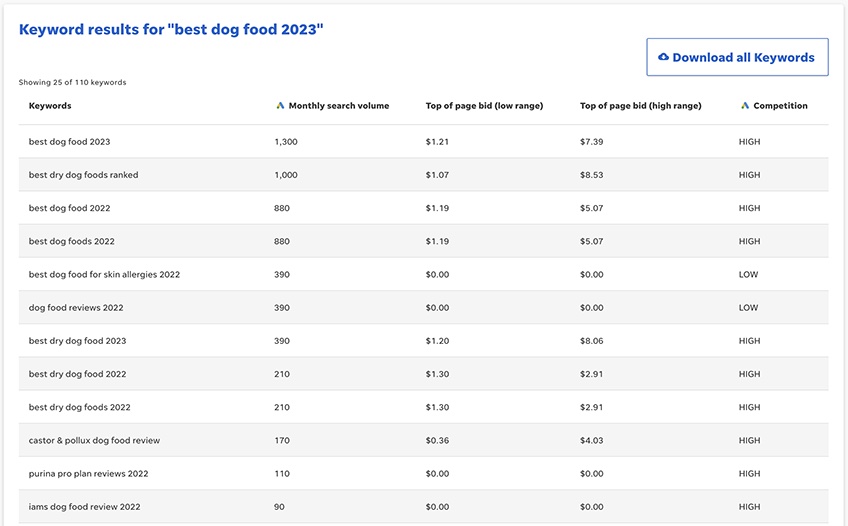
Recently, PPC has been taking the online advertising market by storm, piggybacking on the rising popularity of other search engines (Bing, DuckDuckGo) and combing its way through the disruption caused by the advent of ChatGPT and GPT-like chatbots. For the battle-hardened advertising vets, this was hardly a surprising outcome, as many saw it as an inevitable evolution of dynamic ads.
In fact, PPC has always been the most customizable marketing strategy out there compared to some of the other popular website monetization methods, and that’s due to a few main reasons:
- It allows you to target a specific subset of your existing or new audience with highly relevant ads
- It allows you to write, customize, change, and test your ads indefinitely as long as you have the budget and the time for it
- You can receive tons of help from the advertising platform, including advice for optimal ad placement, the ideal number of ads, and how to keep the code snippets fresh and functional to improve your CTR
To start making money with PPC advertising, it’s recommended to have a marketable website that has at least 1,000 organic visits per month already—as well as a great deal of patience because your PPC beginnings will mostly involve testing the ads, fixing code, and trying to align various HTML block elements so that your ads don’t end up looking lopsided, cheap, and untrustworthy.
If you enter the PPC ecosystem as an advertiser, you can expect to pay an average of $2.59 per click. To calculate how much you can earn from hosting ads on your site with Google AdSense, you can visit the official revenue calculator, select your main advertising category, pick your advertising region, and click Calculate.
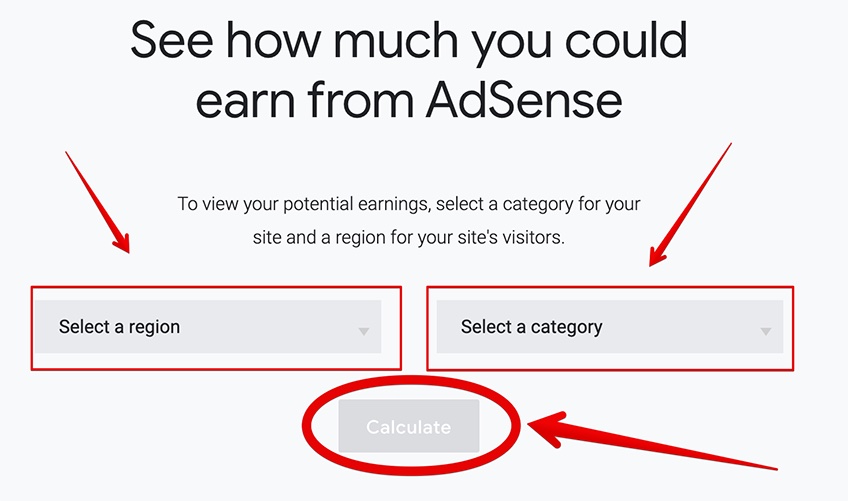
Lastly, it’s not a secret that PPC has been constantly changing and evolving over the years, prompting advertisers to rethink their ways of doing business. As it currently stands, the consensus for PPC is that it’s a legitimate way of making money online, but the oversaturated bidding wars make it very challenging for both new and returning advertisers to achieve overnight success. So, if you’re thinking about trying it out, you may want to think long-term.
7. Selling Courses
- Advantages: features high-profit margins, unlimited topics to pick from, highly scalable, generates passive income if successful, usually considered a premium product
- Disadvantages: requires an existing audience, even simple courses take a lot of work to put together, low buyer intent
If you feel like you have sufficient expertise in a given area and want to share your knowledge with people who might find it useful, then one idea would be to create a website, put together several high-quality courses, and sell them for a price.
Another alternative is to make an account on one of the more popular course websites like Udemy or Coursera and host your courses on those platforms instead. This approach is good for beginners who don’t have an established audience and want to put their brand out there without taking on the risk of investing in a personal website or buying recording equipment to produce a course.
However, keep in mind that these platforms are not very friendly when it comes to paying out your earnings, as some of them can take a cut that amounts to 50% of your total sales.
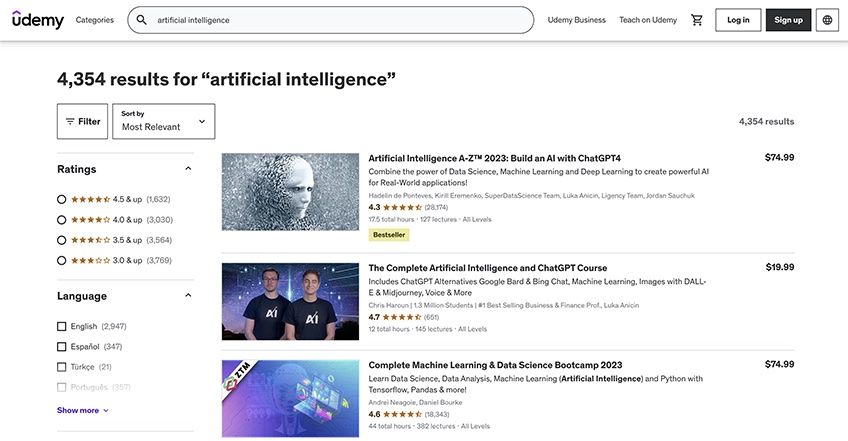
Getting into the business of creating and selling online courses requires many steps:
- Find a subject that you’re well versed in to teach, like digital marketing, communications, or finance
- Get the right recording equipment, including a quality camera, a good microphone, editing software like DaVinci Resolve or Final Cut Pro, and a teleprompter if you’re bad at memorizing scripts
- Create the course and polish it to perfection
- Decide how much to charge for it based on your subject, complexity, and audience—courses can have a price tag from $5 to $2,500 or more
- Host the course on your site or a specialized course platform and start selling
Once your first course is completed, you have to promote it aggressively if you want people outside of your immediate social circles to see it. You can promote your course on social media, hire a gig worker to show it to their connections, or even start a live stream and promote your courses to your viewers that way.
Keep in mind that building your concurrent viewer numbers also takes time, so success is nowhere near guaranteed in this line of work.
That said, if you’re willing to take risks and put yourself out there as the face behind the material in your courses, there’s still a non-zero chance of turning this initial hobby into a reliable source of passive income.
8. Building an Email List
- Advantages: you have complete ownership, trustworthy and highly targeted, low cost, most users check their email daily, direct and purposeful, unmatched return of investment (ROI)
- Disadvantages: privacy concerns, spam, and other malware are a big obstacle, and some users hold a strong stance against opting-in
An email list is a list of email addresses, names, and sometimes other contact information of visitors who have willingly opted in to receive updates, promotions, and other news from your website or blog. You can build your email list using email marketing tools like Klavyio, HubSpot, or OptinMonster.
Similarly, you can also use a simple opt-in form to gather the information and store it in a safe location, usually on a designated server locally or on the cloud. If you’re still unsure about which platform to use, check out our guide on the best email marketing services to see what’s right for you.
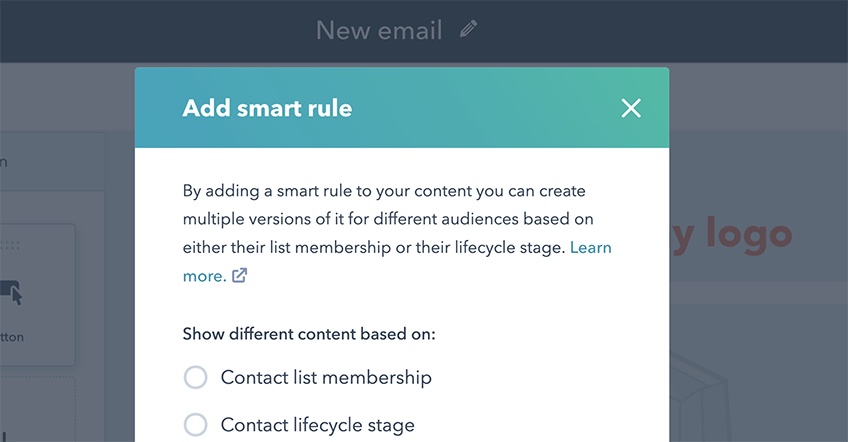
Once you gather a sizable amount of entries in your email list, you can monetize it by:
- Sending dedicated emails—one email features one sponsor
- Selling classified ads—your email contains multiple ads scattered throughout your newsletter in a subtle way
- Featuring sponsored emails—your newsletter features a single, prominent ad
- Creating a tripwire offer—you offer a huge discount on an otherwise expensive deal, up to a 90% discount in some cases
- Sell your products—promote things like an ebook, video coaching sessions, or relevant apps to your target audience
These are just some of the ways to monetize your email list, but if all else fails, you can always bite the proverbial bullet and sell your list to a third-party business that will then use it to promote its own products and services to the contacts on that list.
Of course, you should only do this as a last resort because it can cause a great deal of ire in your audience—and it may even clash with some internet rules and regulations depending on your area of operations. Needless to say, you should just tread very carefully if you decide to go down that route.
At any rate, building an email list is still probably one of the most beginner-friendly website monetization techniques in existence, since the initial investment is so small that any starting marketer would be able to afford it.
Lastly, the basic versions of most website sign-up forms are also free, so you could say that the technical aspect of building an email list is already taken care of. The hard part comes from building an audience and convincing users to share their contact information in exchange for a perk—something like an ebook, or early access to a premium article on your site.
9. Selling Your Site
- Advantages: cashing out quickly, freeing up time, avoiding future risk, getting a lump sum in exchange for potential future earnings
- Disadvantages: low prices, losing out on a steady income stream, signing a non-compete clause, giving up your passion, losing established influence
Selling your site means to assess its real worth before unloading it, and there are several aspects involved in doing so, including:
Setting a ballpark: If your site makes a decent buck and it happens to be in a popular niche, then you can easily list it for 25 to 30 times its monthly revenue. For example, if your site makes $1,500 per month, you can set the initial price at $37,500 and up to $45,000.
Considering all the variables: The total selling cost of your website can change depending on multiple variables such as domain authority, traffic, number of backlinks, and the industry it operates in. Make sure to consider all of these factors before coming up with a price estimate.
Comparing it to similar listings: Check some of the specialized site-flipping platforms like Flippa or Empire Flippers for similar sites and compare your site’s metrics to those for a more accurate estimate on a final selling price. In addition to listings, these platforms also offer a free valuation of your property, sending the results straight to your inbox.
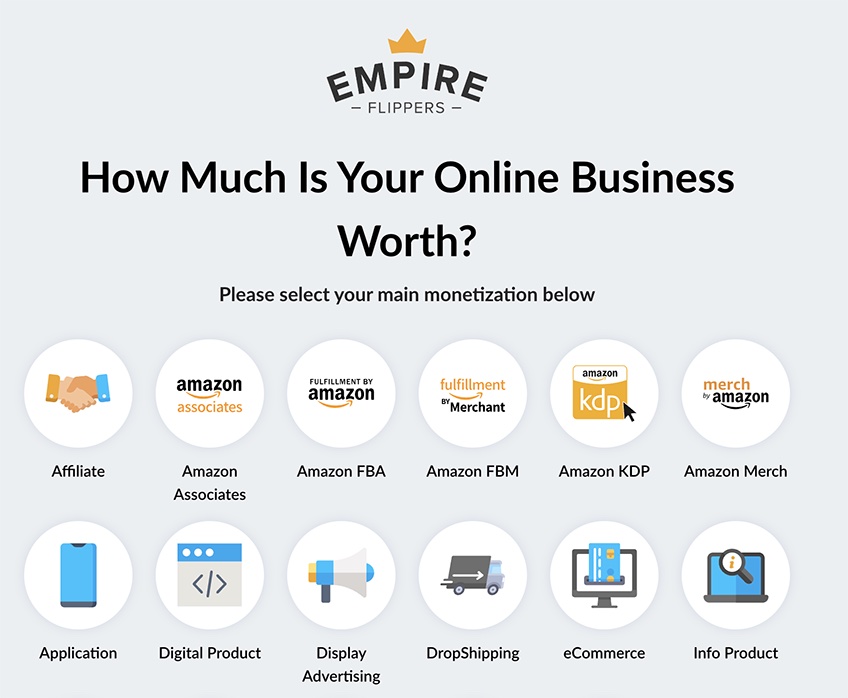
Selling a website will often feel like selling a real estate property because you have to work hard to get through the entire deal from beginning to end. There’s a lot of online noise that can drive a new buyer or seller crazy, and the recent emergence of fake listings and falsified site metrics are not helping.
Thankfully, these are considered edge cases, and most market participants are trying to close a legitimate deal without scamming anyone. Still, it’s a good idea to mention it, so err on the side of caution when assessing the legitimacy of any listed property.
When listing your site, make sure that the information is:
- Valid, authentic, and up-to-date—you can use a tool like SemRUSH, Ahrefs, or Google Analytics (GA) to gather all the required statistics, then organize them in Excel or Google Sheets to show that you mean business
- Highly specific—try to include as much data as you can without overstuffing your listing
- Easily digestible—if some of the graphs, analytics, or visuals look too complex, cut them out from your listing outright, as the last thing you want to do is to scare away your potential buyers with confusing data
Recap
With all of the different methods to make money with a website, remember the important factors for success:
- Build and treat the site as a brand
- Write compelling content
- Work to drive a reasonable amount of organic traffic
- Keep your audience interested
If you can do all of those things well, then it’s hard to go wrong with any of the monetization methods covered above. It’s up to you to decide which method has the best chances for you starting out, but with any luck, you’ll be able to combine a few of them.
To learn more about selling a site, check out our website flipping guide, which goes through the entire process in an easily digestible way.
